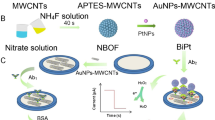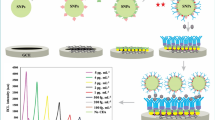Abstract
Establishing an effective signal amplification strategy is the key to achieving sensitive detection of analytes by electrochemical immunoassay. In this work, a novel sandwich-type electrochemical immunosensor with dual-signal amplification was successfully constructed using PtPd/Cu-TCPP(Fe) as the sensing platform and mesoporous silicon dioxide as the signal amplifier. Firstly, two-dimensional wrinkled Cu-TCPP(Fe) nanomaterials loaded with PtPd nanoparticles have strong affinity for the immobilization of capture antibodies and can generate excellent electrochemical signals. Meanwhile, the mesoporous silicon dioxide with large steric hindrance was used as signal label to further improve the sensitivity of the immunosensor by increasing the difference of the current response signal. Under optimal experimental conditions, the electrochemical immunosensor exhibited a wide linear detection range from 0.1 pg/mL to 1.0 μg/mL, with a detection limit as low as 0.166 fg/mL. The experimental results showed that the constructed immunosensor has a great application prospect in clinical biomarker detection.
Graphical Abstract






Similar content being viewed by others
References
Sung H, Ferlay J, Siegel RL, Laversanne M, Soerjomataram I, Jemal A, Bray F. Global Cancer Statistics 2020: GLOBOCAN estimates of incidence and mortality worldwide for 36 cancers in 185 countries. CA Cancer J Clin. 2021;71(3):209–49. https://doi.org/10.3322/caac.21660.
Uygur MM, Gumus M. The utility of serum tumor markers CEA and CA 15–3 for breast cancer prognosis and their association with clinicopathological parameters. Cancer Treat Res Commun. 2021;28:100402. https://doi.org/10.1016/j.ctarc.2021.100402.
Xu Y, Zhang P, Zhang K. Huang C (2021) The application of CA72-4 in the diagnosis, prognosis, and treatment of gastric cancer. Biochim Biophys Acta Rev Cancer. 1876;2:188634. https://doi.org/10.1016/j.bbcan.2021.188634.
Hing JX, Mok CW, Tan PT, Sudhakar SS, Seah CM, Lee WP, Tan SM. Clinical utility of tumour marker velocity of cancer antigen 15–3 (CA 15–3) and carcinoembryonic antigen (CEA) in breast cancer surveillance. Breast. 2020;52:95–101. https://doi.org/10.1016/j.breast.2020.05.005.
Labib M, Sargent EH, Kelley SO. Electrochemical Methods for the Analysis of Clinically Relevant Biomolecules. Chem Rev. 2016;116(16):9001–90. https://doi.org/10.1021/acs.chemrev.6b00220.
Kim CG, Ahn JB, Jung M, Beom SH, Heo SJ, Kim JH, Kim YJ, Kim NK, Min BS, Koom WS, Kim H, Roh YH, Ma BG, Shin SJ. Preoperative serum carcinoembryonic antigen level as a prognostic factor for recurrence and survival after curative resection followed by adjuvant chemotherapy in stage III colon cancer. Ann Surg Oncol. 2017;24(1):227–35. https://doi.org/10.1245/s10434-016-5613-5.
Nam SE, Lim W, Jeong J, Lee S, Choi J, Park H, Jung YS, Jung SP, Bae SY. The prognostic significance of preoperative tumor marker (CEA, CA15-3) elevation in breast cancer patients: data from the Korean Breast Cancer Society Registry. Breast Cancer Res Treat. 2019;177(3):669–78. https://doi.org/10.1007/s10549-019-05357-y.
Lin YH, Wu CH, Fu HC, Chen YJ, Chen YY, Ou YC, Lin H. Prognostic significance of elevated pretreatment serum levels of CEA and CA-125 in epithelial ovarian cancer. Cancer Biomark. 2020;28(3):285–92. https://doi.org/10.3233/CBM-201455.
Arici S, Karyagar SS, Erdemir RU, Cekin R, Atcı MM, Güven O, Karyagar S, Cihan Ş. The correlation between tumor markers and Ga-68 DOTA-TATE PET/CT findings in patients with advanced medullary thyroid cancer. Revista Española de Medicina Nuclear e Imagen Molecular (English Edition). 2021;40(3):161–6. https://doi.org/10.1016/j.remnie.2020.04.005.
Hui D, Kim SH, Roquemore J, Dev R, Chisholm G, Bruera E. Impact of timing and setting of palliative care referral on quality of end-of-life care in cancer patients. Cancer. 2014;120(11):1743–9. https://doi.org/10.1002/cncr.28628.
Sun J, Ning X, Cui L, Ling M, Xu X, He S. Assembly of “carrier free” enzymatic nano-reporters for improved ELISA. Analyst. 2020;145(20):6541–8. https://doi.org/10.1039/d0an00585a.
Wu H, Zhao M, Li J, Zhou X, Yang T, Zhao D, Liu P, Ju H, Cheng W, Ding S. Novel protease-free long-lasting chemiluminescence system based on the Dox-ABEI chimeric magnetic DNA hydrogel for ultrasensitive immunoassay. ACS Appl Mater Interfaces. 2020;12(42):47270–7. https://doi.org/10.1021/acsami.0c14188.
Zhu J, Dong H, Zhang Q, Zhang S. Combined assays for serum carcinoembryonic antigen and microRNA-17-3p offer improved diagnostic potential for stage I/II colon cancer. Mol Clin Oncol. 2015;3(6):1315–8. https://doi.org/10.3892/mco.2015.616.
Yang X, Zhuo Y, Zhu S, Luo Y, Feng Y, Xu Y. Selectively assaying CEA based on a creative strategy of gold nanoparticles enhancing silver nanoclusters’ fluorescence. Biosens Bioelectron. 2015;64:345–51. https://doi.org/10.1016/j.bios.2014.09.029.
Chen Y, Wang AJ, Yuan PX, Luo X, Xue Y, Feng JJ. Three dimensional sea-urchin-like PdAuCu nanocrystals/ferrocene-grafted-polylysine as an efficient probe to amplify the electrochemical signals for ultrasensitive immunoassay of carcinoembryonic antigen. Biosens Bioelectron. 2019;132:294–301. https://doi.org/10.1016/j.bios.2019.02.057.
Felix FS, Angnes L. Electrochemical immunosensors - a powerful tool for analytical applications. Biosens Bioelectron. 2018;102:470–8. https://doi.org/10.1016/j.bios.2017.11.029.
Jia Y, Li Y, Zhang S, Wang P, Liu Q, Dong Y. Mulberry-like Au@PtPd porous nanorods composites as signal amplifiers for sensitive detection of CEA. Biosens Bioelectron. 2020;149:111842. https://doi.org/10.1016/j.bios.2019.111842.
Wang X, Liao X, Zhang B, Zhang M, Mei L, Wang F, Chen S, Qiao X, Hong C. An electrochemical immunosensor for the detection of carcinoembryonic antigen based on Au/g-C3N4 NSs-modified electrode and CuCo/CNC as signal tag. Mikrochim Acta. 2021;188(12):408. https://doi.org/10.1007/s00604-021-05013-7.
Ma E, Wang P, Yang Q, Yu H, Pei F, Li Y, Liu Q, Dong Y. Electrochemical immunosensor based on MoS2 NFs/Au@AgPt YNCs as signal amplification label for sensitive detection of CEA. Biosens Bioelectron. 2019;142:111580. https://doi.org/10.1016/j.bios.2019.111580.
Cai ZX, Wang ZL, Kim J, Yamauchi Y. Hollow functional materials derived from metal-organic frameworks: synthetic strategies, conversion mechanisms, and electrochemical applications. Adv Mater. 2019;31(11):e1804903. https://doi.org/10.1002/adma.201804903.
Mohan B, Kumar S, Xi H, Ma S, Tao Z, Xing T, You H, Zhang Y, Ren P. Fabricated metal-organic frameworks (MOFs) as luminescent and electrochemical biosensors for cancer biomarkers detection. Biosens Bioelectron. 2022;197:113738. https://doi.org/10.1016/j.bios.2021.113738.
Niu X, Li X, Lyu Z, Pan J, Ding S, Ruan X, Zhu W, Du D, Lin Y. Metal-organic framework based nanozymes: promising materials for biochemical analysis. Chem Commun (Camb). 2020;56(77):11338–53. https://doi.org/10.1039/d0cc04890a.
Tang J, Liu Y, Hu J, Zheng S, Wang X, Zhou H, Jin B (2020) Co-based metal-organic framework nanopinnas composite doped with Ag nanoparticles: a sensitive electrochemical sensing platform for simultaneous determination of dopamine and acetaminophen. Microchem J 155. https://doi.org/10.1016/j.microc.2020.104759.
Li X, Li X, Li D, Zhao M, Wu H, Shen B, Liu P, Ding S. Electrochemical biosensor for ultrasensitive exosomal miRNA analysis by cascade primer exchange reaction and MOF@Pt@MOF nanozyme. Biosens Bioelectron. 2020;168:112554. https://doi.org/10.1016/j.bios.2020.112554.
Chen J, Shu Y, Li H, Xu Q, Hu X. Nickel metal-organic framework 2D nanosheets with enhanced peroxidase nanozyme activity for colorimetric detection of H2O2. Talanta. 2018;189:254–61. https://doi.org/10.1016/j.talanta.2018.06.075.
Ma J, Chen G, Bai W, Zheng J. Amplified electrochemical hydrogen peroxide sensing based on Cu-porphyrin metal-organic framework nanofilm and G-quadruplex-hemin DNAzyme. ACS Appl Mater Interfaces. 2020;12(52):58105–12. https://doi.org/10.1021/acsami.0c09254.
Liu Q, Yang Y, Li H, Zhu R, Shao Q, Yang S, Xu J. NiO nanoparticles modified with 5,10,15,20-tetrakis(4-carboxyl pheyl)-porphyrin: promising peroxidase mimetics for H2O2 and glucose detection. Biosens Bioelectron. 2015;64:147–53. https://doi.org/10.1016/j.bios.2014.08.062.
Huang Y, Zhao M, Han S, Lai Z, Yang J, Tan C, Ma Q, Lu Q, Chen J, Zhang X, Zhang Z, Li B, Chen B, Zong Y, Zhang H (2017) Growth of Au nanoparticles on 2D metalloporphyrinic metal-organic framework nanosheets used as biomimetic catalysts for cascade reactions. Adv Mater 29 (32). https://doi.org/10.1002/adma.201700102.
Gan X, Han D, Wang J, Liu P, Li X, Zheng Q, Yan Y. A highly sensitive electrochemiluminescence immunosensor for h-FABP determination based on self-enhanced luminophore coupled with ultrathin 2D nickel metal-organic framework nanosheets. Biosens Bioelectron. 2021;171:112735. https://doi.org/10.1016/j.bios.2020.112735.
Xiao J, Hu X, Wang K, Zou Y, Gyimah E, Yakubu S, Zhang Z. A novel signal amplification strategy based on the competitive reaction between 2D Cu-TCPP(Fe) and polyethyleneimine (PEI) in the application of an enzyme-free and ultrasensitive electrochemical immunosensor for sulfonamide detection. Biosens Bioelectron. 2020;150:111883. https://doi.org/10.1016/j.bios.2019.111883.
Zhao M, Wang Y, Ma Q, Huang Y, Zhang X, Ping J, Zhang Z, Lu Q, Yu Y, Xu H, Zhao Y, Zhang H. Ultrathin 2D metal-organic framework nanosheets. Adv Mater. 2015;27(45):7372–8. https://doi.org/10.1002/adma.201503648.
Xie LS, Skorupskii G, Dinca M. Electrically conductive metal-organic frameworks. Chem Rev. 2020;120(16):8536–80. https://doi.org/10.1021/acs.chemrev.9b00766.
Wang K, He B, Xie L, Li L, Yang J, Liu R, Wei M, Jin H, Ren W (2021) Exonuclease III-assisted triple-amplified electrochemical aptasensor based on PtPd NPs/PEI-rGO for deoxynivalenol detection. Sensors and Actuators B: Chemical 349. https://doi.org/10.1016/j.snb.2021.130767.
Yu Y, Yu C, Niu Y, Chen J, Zhao Y, Zhang Y, Gao R, He J. Target triggered cleavage effect of DNAzyme: relying on Pd-Pt alloys functionalized Fe-MOFs for amplified detection of Pb(2). Biosens Bioelectron. 2018;101:297–303. https://doi.org/10.1016/j.bios.2017.10.006.
Tang J, Zhu X, Niu X, Liu T, Zhao H, Lan M. Anamperometric superoxide anion radicalbiosensor based on SOD/PtPd-PDARGO modified electrode. Talanta. 2015;137:18–24. https://doi.org/10.1016/j.talanta.2015.01.009.
Tan Z, Dong H, Liu Q, Liu H, Zhao P, Wang P, Li Y, Zhang D, Zhao Z, Dong Y. A label-free immunosensor based on PtPd NCs@MoS2 nanoenzymes for hepatitis B surface antigen detection. Biosens Bioelectron. 2019;142:111556. https://doi.org/10.1016/j.bios.2019.111556.
Chen KJ, Lee CF, Rick J, Wang SH, Liu CC, Hwang BJ. Fabrication and application of amperometric glucose biosensor based on a novel PtPd bimetallic nanoparticle decorated multi-walled carbon nanotube catalyst. Biosens Bioelectron. 2012;33(1):75–81. https://doi.org/10.1016/j.bios.2011.12.020.
Liu W, Yang H, Ge S, Shen L, Yu J, Yan M, Huang J. Application of bimetallic PtPd alloy decorated graphene in peroxydisulfate electrochemiluminescence aptasensor based on Ag dendrites decorated indium tin oxide device. Sens Actuators, B Chem. 2015;209:32–9. https://doi.org/10.1016/j.snb.2014.11.079.
Huang R, Shen YW, Guan YY, Jiang YX, Wu Y, Rahman K, Zhang LJ, Liu HJ, Luan X. Mesoporous silica nanoparticles: facile surface functionalization and versatile biomedical applications in oncology. Acta Biomater. 2020;116:1–15. https://doi.org/10.1016/j.actbio.2020.09.009.
Poostforooshan J, Belbekhouche S, Shaban M, Alphonse V, Habert D, Bousserrhine N, Courty J, Weber AP. Aerosol-assisted synthesis of tailor-made hollow mesoporous silica microspheres for controlled release of antibacterial and anticancer agents. ACS Appl Mater Interfaces. 2020;12(6):6885–98. https://doi.org/10.1021/acsami.9b20510.
Xu W, Qin Z, Hao Y, He Q, Chen S, Zhang Z, Peng D, Wen H, Chen J, Qiu J, Li C. A signal-decreased electrochemical immunosensor for the sensitive detection of LAG-3 protein based on a hollow nanobox-MOFs/AuPt alloy. Biosens Bioelectron. 2018;113:148–56. https://doi.org/10.1016/j.bios.2018.05.010.
Acknowledgements
We would like to thank Professor Lian Xuemei (Centre for Lipid Research & Key Laboratory of Molecular Biology for Infectious Diseases (Ministry of Education), the Second Affiliated Hospital, Chongqing Medical University, 400016, Chongqing, China) for providing the serum samples, which helped us a lot in the experiment of real sample analysis.
Funding
This work was supported by the Natural Science Foundation of Chongqing, China (No. cstc2019jcyj-msxmX0121).
Author information
Authors and Affiliations
Contributions
Liu Jie: Conceptualization; methodology; data curation; visualization; writing, original draft; writing, review and editing. Zhang Zixuan: Methodology, writing—review and editing. Li Ying: Supervision. Dong Jie: Supervision. Li Chaorui: Conceptualization, project administration, writing—review and editing.
Corresponding author
Ethics declarations
Ethics approval
This work has been approved by the First Affiliated Hospital of Chongqing Medical University (2020–542) and has been performed in accordance with the ethical standards.
Source of biological material
Human serum samples were obtained from the First Affiliated Hospital of Chongqing Medical University.
Competing interests
The authors declare no competing interests.
Additional information
Publisher’s note
Springer Nature remains neutral with regard to jurisdictional claims in published maps and institutional affiliations.
Supplementary information
Below is the link to the electronic supplementary material.
Rights and permissions
Springer Nature or its licensor (e.g. a society or other partner) holds exclusive rights to this article under a publishing agreement with the author(s) or other rightsholder(s); author self-archiving of the accepted manuscript version of this article is solely governed by the terms of such publishing agreement and applicable law.
About this article
Cite this article
Liu, J., Zhang, Z., Li, Y. et al. An ultrasensitive electrochemical immunosensor for carcinoembryonic antigen detection based on two-dimensional PtPd/Cu-TCPP(Fe) nanocomposites. Anal Bioanal Chem 415, 447–456 (2023). https://doi.org/10.1007/s00216-022-04425-5
Received:
Revised:
Accepted:
Published:
Issue Date:
DOI: https://doi.org/10.1007/s00216-022-04425-5




